Structural and Performance Optimization of Environmentally Friendly Phenolic Resin/Polyvinyl Alcohol/Pure Terephthalic Acid/Silicone Carbide (PF/PVA/PTA/SiC) Porous Composite Grinding Wheels Prepared via Freeze-Drying Methodology
Abstract
:1. Introduction
2. Materials and Methods
2.1. Materials
2.2. Green Manufacturing of the PF/PVA/PTA/SiC Grinding Wheel
2.3. Measurement and Characterization
2.3.1. Thermal Behavior Analysis
2.3.2. Fourier Infrared Spectral Analysis
2.3.3. Porosity Detection
2.3.4. Depth-of-Field Microscope
2.3.5. Scanning Electron Microscope
2.3.6. Mechanical Properties
2.3.7. Freeze-Drying Process
2.3.8. Grinding Test
3. Results and Discussion
3.1. Thermal Behavior Analysis and Fourier Transform Infrared Spectroscopy (FT-IR) of Phenolic Resin/Polyvinyl Alcohol/Pure Terephthalic Acid (PF/PVA/PTA) Composites
3.2. Effect of Freeze-Drying Time on the Forming of Phenolic Resin/Polyvinyl Alcohol/Pure Terephthalic Acid (PF/PVA/PTA) Composites
3.3. Effect of Freeze-Drying Time on the Mechanical Properties of Phenolic Resin/Polyvinyl Alcohol/Pure Terephthalic Acid (PF/PVA/PTA) Composites
3.4. Comprehensive Mechanical Properties Analysis of Phenolic Resin/Polyvinyl Alcohol/Pure Terephthalic Acid/Silicone Carbide (PF/PVA/PTA/SiC) Composites
3.5. Pore Structure and Distribution of Polyvinyl Alcohol/Phenolic Resin/Pure Terephthalic Acid/Silicone Carbide (PVA/PF/PTA/SiC) Composite Grinding Wheel
3.6. Scanning Electrone Microscope (SEM) of Pore Structure and Abrasive Particle Distribution of the Polyvinyl Alcohol (PVA) Grinding Wheels
3.7. Grinding Test for Four Kinds of Polyvinyl Alcohol (PVA) Grinding Wheels
4. Conclusions
Author Contributions
Funding
Institutional Review Board Statement
Informed Consent Statement
Data Availability Statement
Conflicts of Interest
References
- Xiang, L.; Yu, X.; Xiang, A.; Lu, X.; Zhang, M.; Zhou, H. Pore structure evolution and adsorption behaviors of porous poly (vinyl alcohol) hydrogel prepared using Na2SO4 and CaCO3 as porogens. Polym. Eng. Sci. 2024, 64, 3488–3504. [Google Scholar] [CrossRef]
- Xi, Y.; Hu, L.; Chen, X.; Zuo, L.; Bai, X.; Du, W.; Xu, N. Antibacterial and Anti-Inflammatory Polysaccharide from Fructus Ligustri Lucidi Incorporated in PVA/Pectin Hydrogels Accelerate Wound Healing. Molecules 2024, 29, 1423. [Google Scholar] [CrossRef] [PubMed]
- Li, J.; Li, Y.; Niu, S.; Liu, J.; Wang, L. Synthesis of a new “green” sponge via transesterification of dimethyl carbonate with polyvinyl alcohol and foaming approach. J. Porous Mater. 2017, 24, 1595–1604. [Google Scholar] [CrossRef]
- Gaina, C.; Ursache, O.; Gaina, V.; Buruiana, E.; Ionita, D. Investigation on the thermal properties of new thermo-reversible networks based on poly(vinyl furfural) and multifunctional maleimide compounds. eXPRESS Polym. Lett. 2012, 6, 129–141. [Google Scholar] [CrossRef]
- Sha, D.; Zheng, R.; Wang, B.; Xu, J.; Shi, K.; Yang, X.; Ji, X. Superhydrophilic polyvinyl alcohol-formaldehyde composite sponges with hierachical pore structure for oil/water emulsion separation. React. Funct. Polym. 2021, 165, 104975. [Google Scholar] [CrossRef]
- Zhou, Z.Z.; Li, Z.; Yuan, J.L. Computer Aided Formula Design of PVA Abrasive Tool by Polynomial Regression. Adv. Mater. Res. 2011, 215, 182–185. [Google Scholar] [CrossRef]
- Mizobuchi, A.; Tashima, A. Optimization of Wet Grinding Conditions of Sheets Made of Stainless Steel. J. Manuf. Mater. Process. 2020, 4, 114. [Google Scholar] [CrossRef]
- Song, T.; Tanpichai, S.; Oksman, K. Cross-linked polyvinyl alcohol (PVA) foams reinforced with cellulose nanocrystals (CNCs). Cellulose 2016, 23, 1925–1938. [Google Scholar] [CrossRef]
- Shi, K.; Liu, Z.; Pan, Y.; Wang, B.; Xu, J.; Sha, D.; Yang, X.; Ji, X. Preparation of macroporous polyvinyl alcohol formaldehyde based hydrogels and their dual thermo- and pH-responsive behavior. Appl. Surf. Sci. 2020, 509, 144754. [Google Scholar] [CrossRef]
- Hu, D.Y.; Wang, L.J. Preparation and characterization of antibacterial films based on polyvinyl alcohol/quaternized cellulose. React. Funct. Polym. 2016, 101, 90–98. [Google Scholar] [CrossRef]
- Guastaferro, M.; Baldino, L.; Reverchon, E.; Cardea, S. Production of Porous Agarose-Based Structures: Freeze-Drying vs. Supercritical CO2 Drying. Gels 2021, 7, 198. [Google Scholar] [CrossRef] [PubMed]
- Chen, H.; Ma, Y.; Lin, X.; Yang, D.; Chen, Z.; Li, X.; Lin, X.; Pan, F.; Ma, Z. Preparation of aligned porous niobium scaffold and the optimal control of freeze-drying process. Ceram. Int. 2018, 44, 17174–17179. [Google Scholar] [CrossRef]
- Yook, S.W.; Jung, H.D.; Park, C.H.; Shin, K.H.; Koh, Y.H.; Estrin, Y.; Kim, H.E. Reverse freeze casting: A new method for fabricating highly porous titanium scaffolds with aligned large pores. Acta Biomater. 2012, 8, 2401–2410. [Google Scholar] [CrossRef] [PubMed]
- Chen, H.M.; Luo, M.; Li, X.; Lin, X.X.; Yang, D. Investigation on the Wettability between Nb-Al Alloy and Porous Al2O3 Ceramics Prepared by Freeze Casting. Adv. Mater. Res. 2011, 299–300, 687–691. [Google Scholar] [CrossRef]
- Adelnia, H.; Ensandoost, R.; Shebbrin Moonshi, S.; Gavgani, J.N.; Vasafi, E.I.; Ta, H.T. Freeze/thawed polyvinyl alcohol hydrogels: Present, past and future. Eur. Polym. J. 2022, 164, 110974. [Google Scholar] [CrossRef]
- Zhang, L.; Wang, Z.; Xu, C.; Li, Y.; Gao, J.; Wang, W.; Liu, Y. High strength graphene oxide/polyvinyl alcohol composite hydrogels. J. Mater. Chem. 2011, 21, 10399–10406. [Google Scholar] [CrossRef]
- Zhang, Z.; Wang, S.; Lucia, L.A.; Abidi, N. Processing physically crosslinked polyvinyl alcohol hydrogel into solid foams via freeze-drying: The role of hydrogel state. Polymer 2024, 307, 127313. [Google Scholar] [CrossRef]
- Wang, Z.; Zhu, W.; Huang, R.; Zhang, Y.; Jia, C.; Zhao, H.; Chen, W.; Xue, Y. Fabrication and Characterization of Cellulose Nanofiber Aerogels Prepared via Two Different Drying Techniques. Polymers 2020, 12, 2583. [Google Scholar] [CrossRef]
- Salehpour, S.; Rafieian, F.; Jonoobi, M.; Oksman, K. Effects of molding temperature, pressure and time on polyvinyl alcohol nanocomposites properties produced by freeze drying technique. Ind. Crops Prod. 2018, 121, 1–9. [Google Scholar] [CrossRef]
- Feng, K.; Zhao, T.; Lyu, B.; Zhou, Z. Ultra-precision grinding of 4H-SiC wafer by PAV/PF composite sol-gel diamond wheel. Adv. Mech. Eng. 2021, 13, 16878140211044929. [Google Scholar] [CrossRef]
- Yang, M.; Nie, Y.J. Study on Modification of Phenolic resin/glass fiber Composite by Polyvinyl alcohol. Appl. Mech. Mater. 2010, 44–47, 3045–3048. [Google Scholar] [CrossRef]
- Wan, C.C.; Li, J. Graphene oxide/cellulose aerogels nanocomposite: Preparation, pyrolysis, and application for electromagnetic interference shielding. Carbohydr. Polym. 2016, 150, 172–179. [Google Scholar] [CrossRef] [PubMed]
- Minguez-Garcia, D.; Montava, I.; Bonet-Aracil, M.; Gisbert-Paya, J.; Diaz-Garcia, P. PVA Nanofibers as an Insoluble pH Sensor. Polymers 2023, 15, 4480. [Google Scholar] [CrossRef]
- Feng, K.; Lyu, B.; Zhao, T.; Yin, T.; Zhou, Z. Fabrication and Application of Gel-Forming CeO2 Fixed Abrasive Tools for Quartz Glass Polishing. Int. J. Precis. Eng. Manuf. 2022, 23, 985–1002. [Google Scholar] [CrossRef]
- Shudo, Y.; Fukuda, M.; Islam, M.S.; Kuroiwa, K.; Sekine, Y.; Karim, M.R.; Hayami, S. 3D porous Ni/NiO(x) as a bifunctional oxygen electrocatalyst derived from freeze-dried Ni(OH)2. Nanoscale 2021, 13, 5530–5535. [Google Scholar] [CrossRef] [PubMed]
- Zhang, Z.; Lucia, L.; Abidi, N. Composites hydrogels with enhanced solid foam formation. Compos. Commun. 2022, 35, 101334. [Google Scholar] [CrossRef]
- Di Muzio, L.; Sergi, C.; Carriero, V.C.; Tirillò, J.; Adrover, A.; Messina, E.; Gaetani, R.; Petralito, S.; Casadei, M.A.; Paolicelli, P. Gelatin-based spongy and compressive resistant cryogels with shape recovery ability as ideal scaffolds to support cell adhesion for tissue regeneration. React. Funct. Polym. 2023, 189, 105607. [Google Scholar] [CrossRef]
- Wu, C.; Zeng, L.; Chang, G.; Zhou, Y.; Yan, K.; Xie, L.; Xue, B.; Zheng, Q. Composite phase change materials embedded into cellulose/polyacrylamide/graphene nanosheets/silver nanowire hybrid aerogels simultaneously with effective thermal management and anisotropic electromagnetic interference shielding. Adv. Compos. Hybrid Mater. 2023, 6, 31. [Google Scholar] [CrossRef]
- Liu, X.; Tan, J.; Long, S. Multi-axis fatigue load spectrum editing for automotive components using generalized S-transform. Int. J. Fatigue 2024, 188, 108503. [Google Scholar] [CrossRef]
- GB/T 33835-2017; Test Method of Impact Strength for Friction Material. Standardization Administration of China (SAC): Beijing, China, 2017.
- GB/T 9341-2008; Plastics—Determination of Flexural Properties. Standardization Administration of China (SAC): Beijing, China, 2008.
- GB/T 2411-2008; Plastics and Ebonite—Determination of Indentation Hardness by Means of a Duronmeter (Shore Hardness). Standardization Administration of China (SAC): Beijing, China, 2008.
- Ma, X.; Gao, Y.; Geng, Y.; Zhang, J.; Lai, Y.; Wang, Y.; Tang, J.; Ren, T. A Multifunctional Organogel Polyelectrolyte for Flexible Supercapacitors. ACS Appl. Energy Mater. 2022, 5, 9303–9308. [Google Scholar] [CrossRef]
- Lee, Y.S.; Chen, Y.C.; Lee, W.J. Effect of Adding Conditions of Polyvinyl Alcohol on the Reaction Behavior and Particle Characteristics of Spherical Phenol-formaldehyde Resin Beads. ChemistrySelect 2022, 7, e202200015. [Google Scholar] [CrossRef]
- Dong, S.; He, L.; Li, L.; Wu, Y.; Wang, X. Investigation of Polyvinyl Alcohol–Phenolic Aldehyde–Polyacrylamide Gel for the Application in Saline Oil Reservoirs for Profile Modification. Energy Fuels 2023, 37, 13710–13720. [Google Scholar] [CrossRef]
- Wang, C.; Liu, Y.; Qu, X.; Shi, B.; Zheng, Q.; Lin, X.; Chao, S.; Wang, C.; Zhou, J.; Sun, Y.; et al. Ultra-Stretchable and Fast Self-Healing Ionic Hydrogel in Cryogenic Environments for Artificial Nerve Fiber. Adv. Mater. 2022, 34, 2105416. [Google Scholar] [CrossRef] [PubMed]
- Guan, M.; Yong, C.; Wang, L. Shear strain and microscopic characterization of a bamboo bonding interface with poly(vinyl alcohol) modified phenol–formaldehyde resin. J. Appl. Polym. Sci. 2013, 130, 1345–1350. [Google Scholar] [CrossRef]
- Zuo, K.H.; Zeng, Y.; Jiang, D. Effect of cooling rate and polyvinyl alcohol on the morphology of porous hydroxyapatite ceramics. Mater. Des. 2010, 31, 3090–3094. [Google Scholar] [CrossRef]
- Butylina, S.; Geng, S.; Oksman, K. Properties of as-prepared and freeze-dried hydrogels made from poly(vinyl alcohol) and cellulose nanocrystals using freeze-thaw technique. Eur. Polym. J. 2016, 81, 386–396. [Google Scholar] [CrossRef]
- Qian, L.; Zhang, H. Controlled freezing and freeze drying: A versatile route for porous and micro-/nano-structured materials. J. Chem. Technol. Biotechnol. 2011, 86, 172–184. [Google Scholar] [CrossRef]
- Lian, Z.; Ye, L. Structure and properties of PVA/PEO hydrogel prepared by freezing/thawing method. J. Thermoplast. Compos. Mater. 2011, 26, 912–922. [Google Scholar] [CrossRef]
- Bai, X.; Ye, Z.-f.; Li, Y.-f.; Zhou, L.-c.; Yang, L.-q. Preparation of crosslinked macroporous PVA foam carrier for immobilization of microorganisms. Process Biochem. 2010, 45, 60–66. [Google Scholar] [CrossRef]
- Xu, X.; He, H.; Zhang, Y.; Zhang, D.; Yang, Z. Influence of Position on the Microstructure of Carbon Black/Polyvinyl Alcohol Composite Obtained by the Directional Freeze-drying Process. J. Macromol. Sci. Part B 2014, 53, 568–574. [Google Scholar] [CrossRef]
- Fu, H.; Li, Y.; Wang, B.; Li, J.; Zeng, J.; Li, J.; Chen, K. Structural change and redispersion characteristic of dried lignin-containing cellulose nanofibril and its reinforcement in PVA nanocomposite film. Cellulose 2021, 28, 7749–7764. [Google Scholar] [CrossRef]
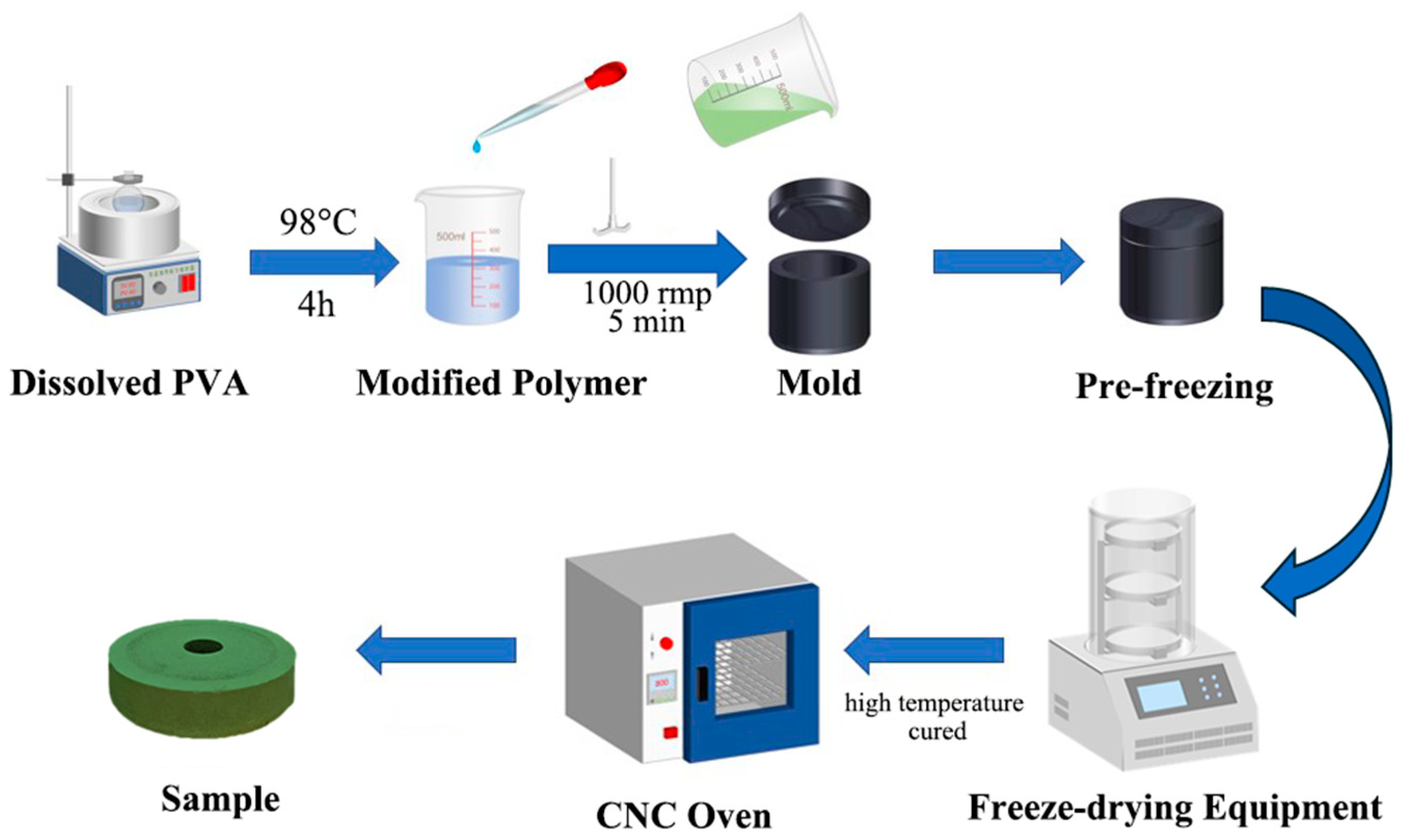

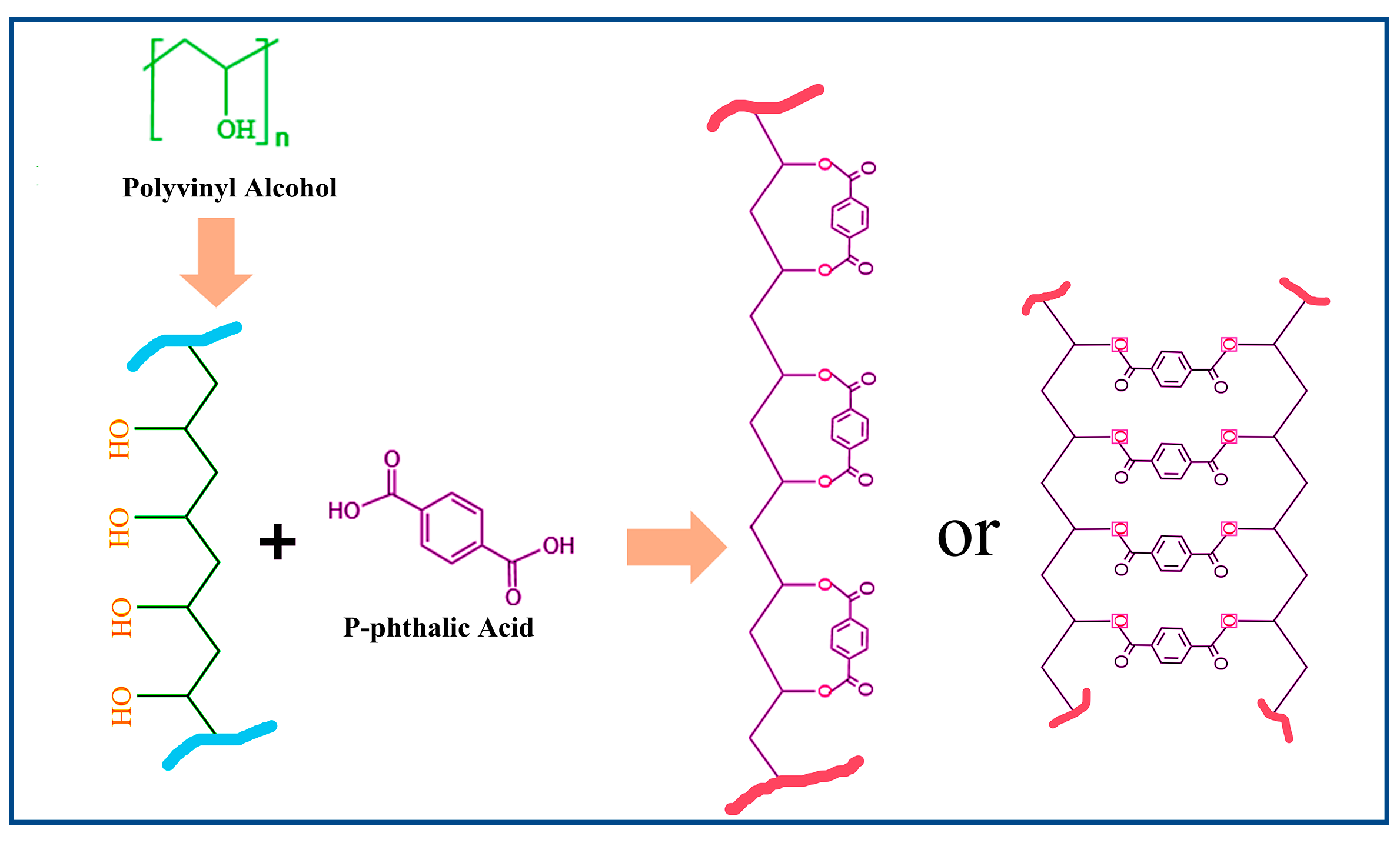

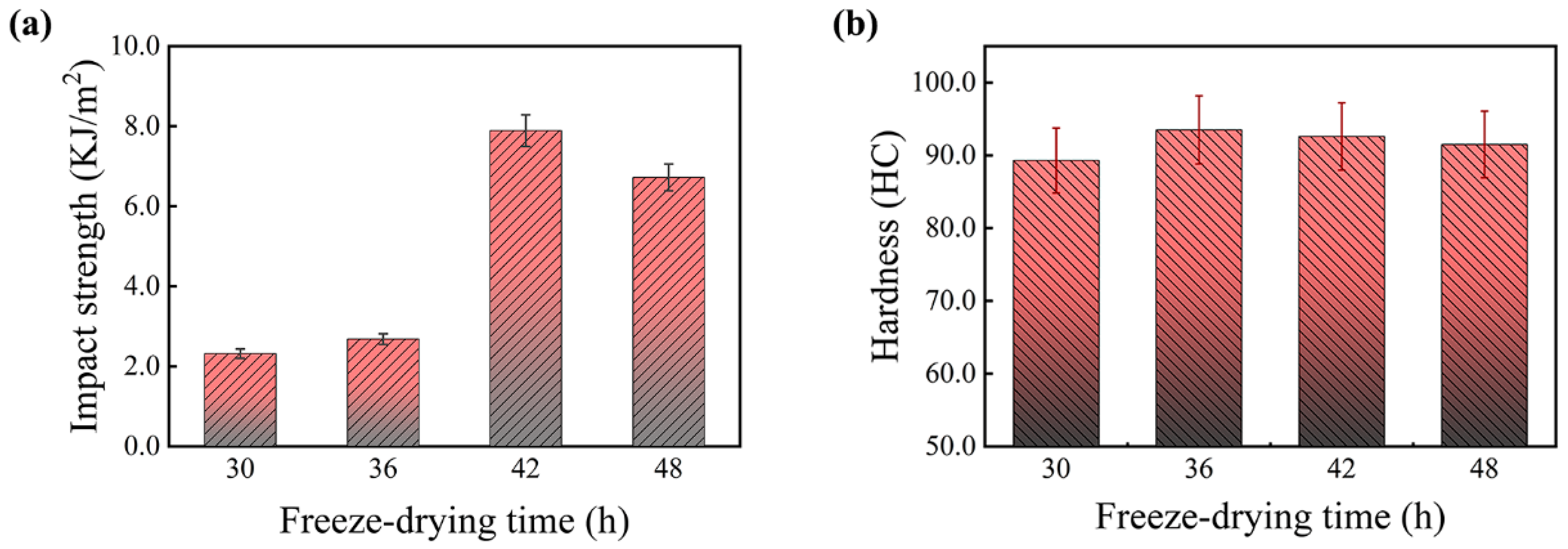

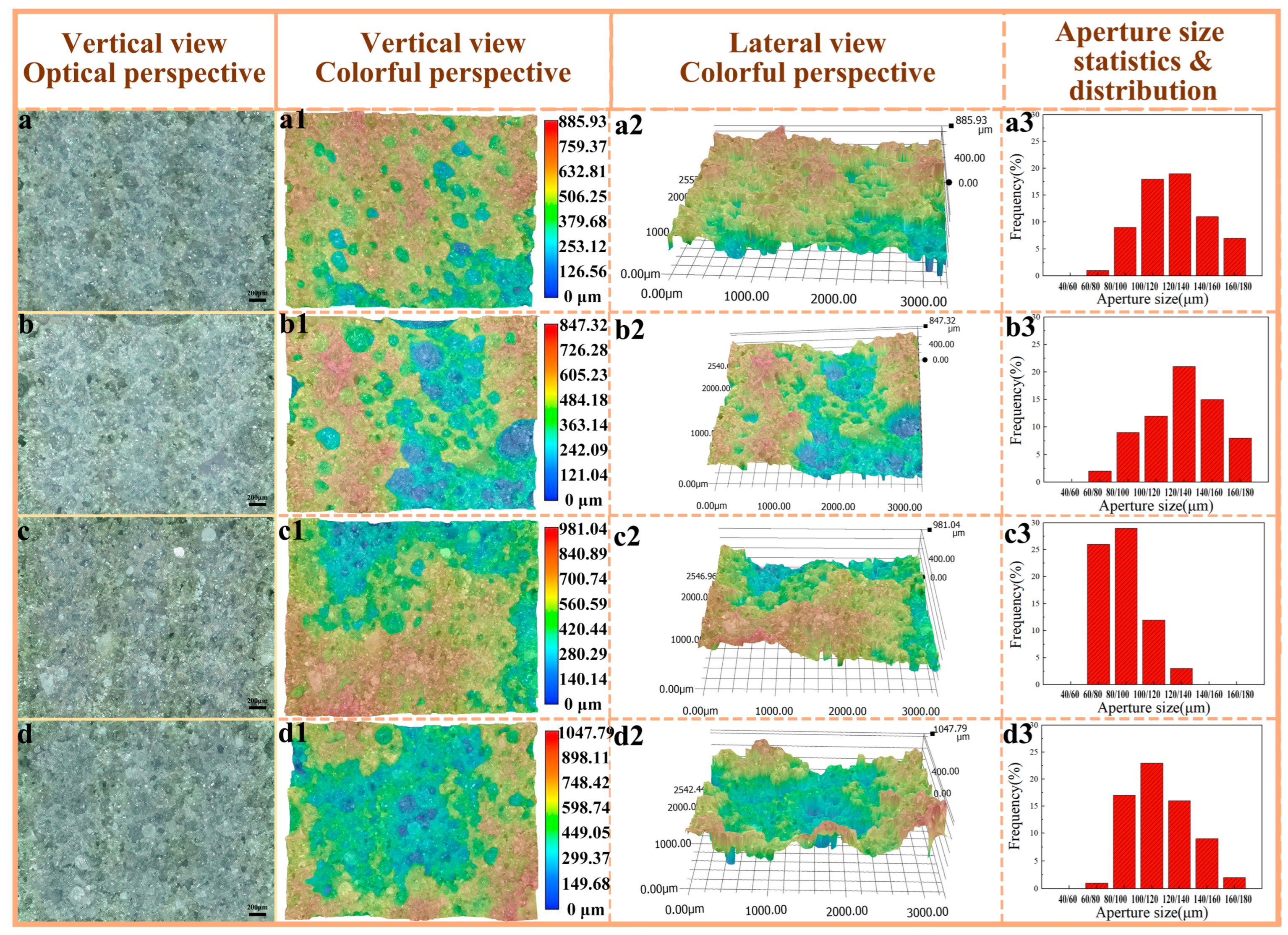
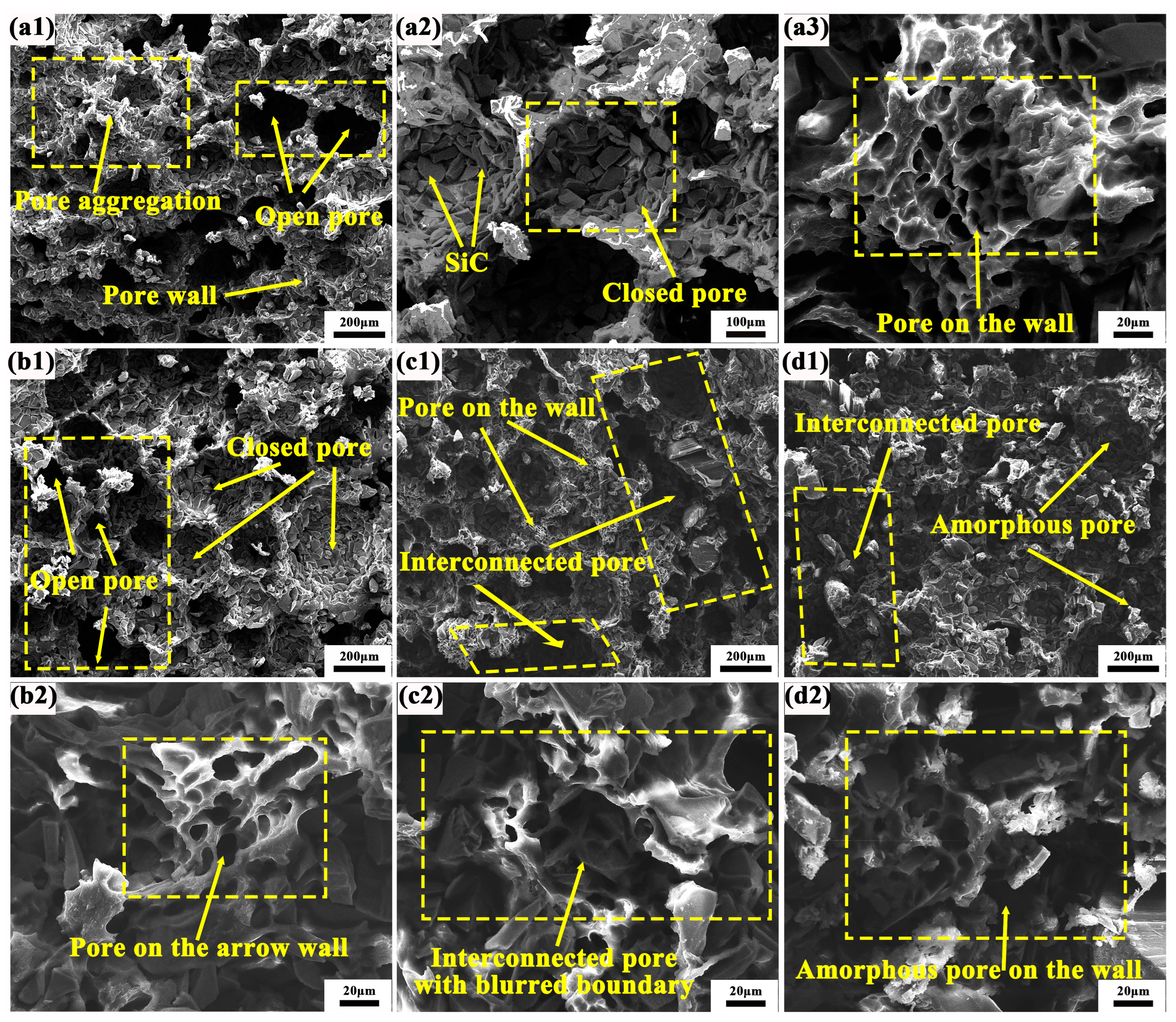
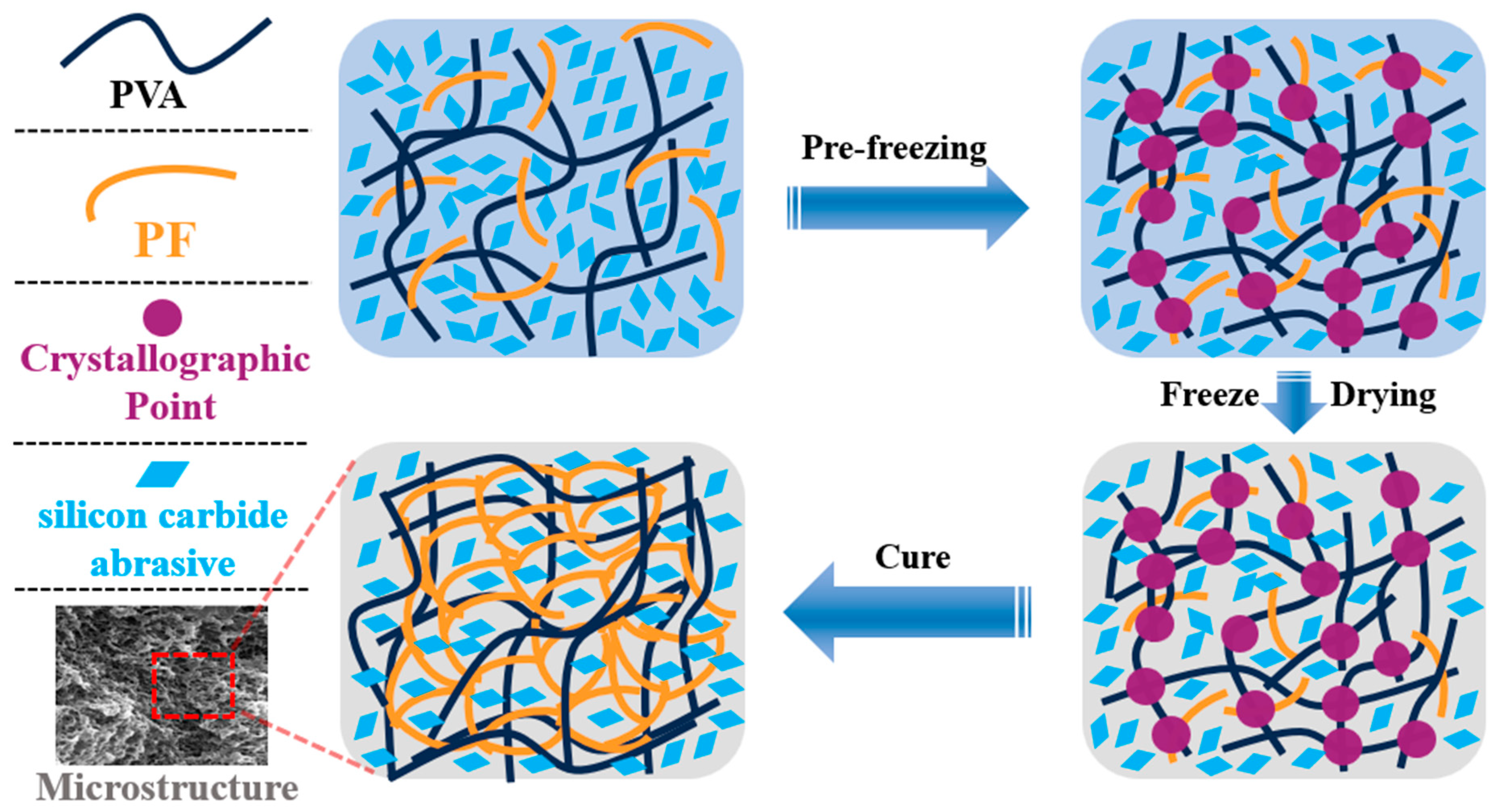
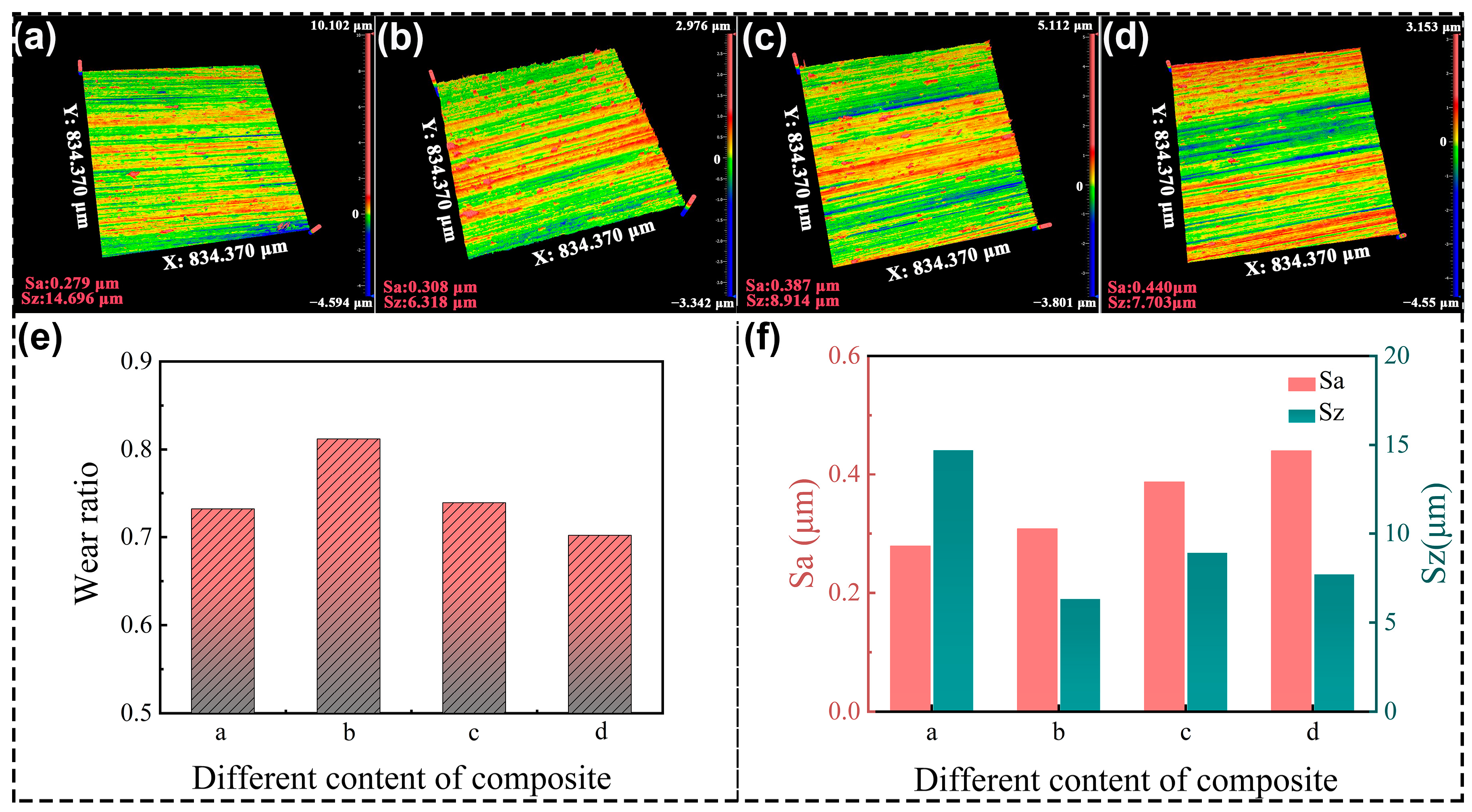
| Component (Mass Content) | PF (75) | PVA-1799 (15) | PVA-2699 (15) | PTA (10) | H2O (135) | SiC-W40 (250) |
|---|---|---|---|---|---|---|
| a | ✓ | ✓ | - | - | ✓ | ✓ |
| b | ✓ | ✓ | - | ✓ | ✓ | ✓ |
| c | ✓ | - | ✓ | - | ✓ | ✓ |
| d | ✓ | - | ✓ | ✓ | ✓ | ✓ |
Disclaimer/Publisher’s Note: The statements, opinions and data contained in all publications are solely those of the individual author(s) and contributor(s) and not of MDPI and/or the editor(s). MDPI and/or the editor(s) disclaim responsibility for any injury to people or property resulting from any ideas, methods, instructions or products referred to in the content. |
© 2025 by the authors. Licensee MDPI, Basel, Switzerland. This article is an open access article distributed under the terms and conditions of the Creative Commons Attribution (CC BY) license (https://creativecommons.org/licenses/by/4.0/).
Share and Cite
Song, X.; Li, X.; Zhao, C.; Liang, L.; Guo, L.; Zhou, Y.; Zhu, B.; Peng, J. Structural and Performance Optimization of Environmentally Friendly Phenolic Resin/Polyvinyl Alcohol/Pure Terephthalic Acid/Silicone Carbide (PF/PVA/PTA/SiC) Porous Composite Grinding Wheels Prepared via Freeze-Drying Methodology. Polymers 2025, 17, 758. https://doi.org/10.3390/polym17060758
Song X, Li X, Zhao C, Liang L, Guo L, Zhou Y, Zhu B, Peng J. Structural and Performance Optimization of Environmentally Friendly Phenolic Resin/Polyvinyl Alcohol/Pure Terephthalic Acid/Silicone Carbide (PF/PVA/PTA/SiC) Porous Composite Grinding Wheels Prepared via Freeze-Drying Methodology. Polymers. 2025; 17(6):758. https://doi.org/10.3390/polym17060758
Chicago/Turabian StyleSong, Xudong, Xuexue Li, Congcong Zhao, Lumin Liang, Liuwei Guo, Yuzhu Zhou, Bingqiao Zhu, and Jin Peng. 2025. "Structural and Performance Optimization of Environmentally Friendly Phenolic Resin/Polyvinyl Alcohol/Pure Terephthalic Acid/Silicone Carbide (PF/PVA/PTA/SiC) Porous Composite Grinding Wheels Prepared via Freeze-Drying Methodology" Polymers 17, no. 6: 758. https://doi.org/10.3390/polym17060758
APA StyleSong, X., Li, X., Zhao, C., Liang, L., Guo, L., Zhou, Y., Zhu, B., & Peng, J. (2025). Structural and Performance Optimization of Environmentally Friendly Phenolic Resin/Polyvinyl Alcohol/Pure Terephthalic Acid/Silicone Carbide (PF/PVA/PTA/SiC) Porous Composite Grinding Wheels Prepared via Freeze-Drying Methodology. Polymers, 17(6), 758. https://doi.org/10.3390/polym17060758





